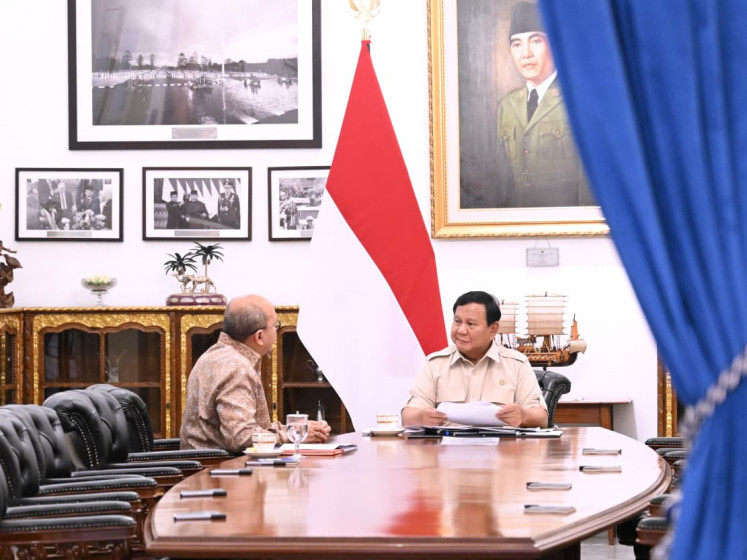Popular Reads
Top Results
Can't find what you're looking for?
View all search resultsPopular Reads
Top Results
Can't find what you're looking for?
View all search results‘The Legend of Tarzan’ A case of subtle white supremacy propaganda?
On the hunt: George Washington Williams (Samuel L
Change text size
Gift Premium Articles
to Anyone
O
span class="caption">On the hunt: George Washington Williams (Samuel L. Jackson, left) and Tarzan (Alexander Skarsgard) are seen in a scene from The Legend of Tarzan.
While The Legend of Tarzan criticizes historical colonialism in Africa, it also conveys a disturbing campaign for white supremacy.
The film takes us back to 1890, a period in history when rich European colonialist states had divided Africa among themselves. King Leopold of Belgium had control of Congo, an area that was rich in natural resources and diamonds.
Leopold’s ambition to build a vast army lands both he and his country in considerable debt. Devising a plan to pay the debt, he sends his most trusted right hand man, Captain Leon Rom (Christoph Waltz), to the depths of the Congo jungle to mine diamonds.
While searching for diamonds, Rom and his men meet a powerful local tribe led by chieftain Mbonga (Djimon Hounsou), whom refuses to give the precious gems to Rom and his men.
An altercation ensues and almost all of Rom’s men are killed by the tribal warriors. Despite this, Mbonga later agrees to give Rom access to the diamonds if he can bring Tarzan (Alexander Skarsgard) to him.
Mbonga’s tribe holds a significant grudge against Tarzan and, as a consequence, the chieftain is willing to pay for Tarzan’s head with all the diamonds in their territory.
In this version of the film Tarzan is civilized and has returned to England. Now known as John Clayton III, Tarzan is the Lord of the House of Greystroke.
As such, this is not the original Edgar Rice Burroughs story that we know and love. Instead Tarzan’s past is narrated through a series of flashbacks, hinting there might be a prequel in the making should this one do well at the box office.
Rom plots to lure Tarzan to Congo; inviting Tarzan and his wife Jane (Margot Robbie) to Congo as part of a trade emissary representing the British Empire.
While reluctant at first, Tarzan eventually agrees after he is convinced by George Washington Williams (Samuel L. Jackson), a US civil war veteran and an African-American diplomat, to investigate if the Belgian Empire is actively engaged in slavery and or exploits natural resources in the region.
In Congo, Rom attempts to capture Tarzan but only manages to capture Jane. Realizing that Tarzan will stop at nothing to save Jane, Rom decides to use her as bait to encourage Tarzan to enter Mbonga’s territory.
Director David Yates — of Harry Potter fame — has added a number of angles and sub-plots on top of what would otherwise have been a relatively simple storyline.
Tarzan is obviously engaged in an internal psychological battle — a man raised by gorillas tries to leave his past behind and live like a normal aristocrat only to be tricked into returning to the jungle.
Personal moment: Tarzan nuzzles his wife, Jane (Margot Robbie).
The hostage situation forces Tarzan to re-embrace his former life. He must first ask for the forgiveness of the gorilla clan that raised him as they had considered him a traitor after he left them to join the humans.
Rather than delve deeper into the psychological aspect, Alexander takes the path of the superhero — swinging from one tree to another while showing off his six-pack and broad shoulders.
The anti-colonialism narrative somehow manages to become a form of white supremacy propaganda as the movie progresses.
The film has an overwhelming number of scenes in which Congolese people are held captive by white Belgian soldiers, liberated by none other than the now aristocratic Tarzan.
To be fair, Tarzan is flanked by Williams in most of the film’s fight scenes. The Williams character is a significant role but is also a kind of comic character and this also comes across as a bit awkward.
There is a brief moment of delight when it is hinted that Williams might be made into a sidekick of equal status to Tarzan but the character, based on a real life historical figure, spends most of his time on screen as Tarzan’s goofy servant.
You can sense the white supremacy in scenes where the Congolese dance around Tarzan and Jane, glorifying them as if they are some kind of gods, sent from the heavens to liberate them, while Williams looks on in awe.
Despite the propaganda, clichéd dialogue, corny jokes and sub-par CGI, the lead actors and actresses play their characters well.
Alexander’s true acting skills can be seen in his portrayal of a psychologically disturbed Tarzan. But he is objectified, spending most of his time showing his muscles and bravado.
Samuel does not have the chance to burst into profanities or exude any of the bad-ass charisma he is known for but, when the time comes for him to shine, he delivers.
Christoph performs well as a charming yet deadly power-hungry opportunist and Margot tries to bring out the sense of empowerment in Jane’s character, rather than just playing the role of the damsel in distress.
— Photos by AP/Warner Bros. Entertainment
________________________________
Legend of Tarzan
(Warner Bros. Pictures; 110 minute)
Directed by David Yates
Starring Alexander Skarsgård; Samuel L. Jackson; Margot Robbie; Djimon Hounsou
Jim Broadbent; Christoph Waltz











